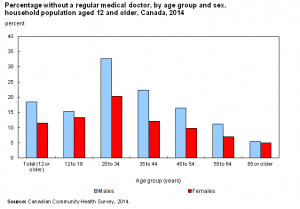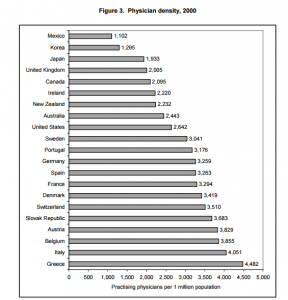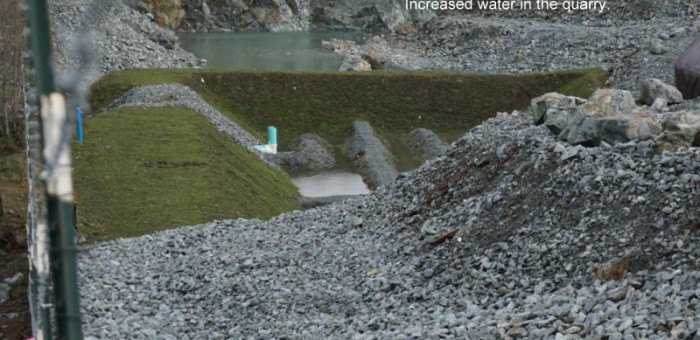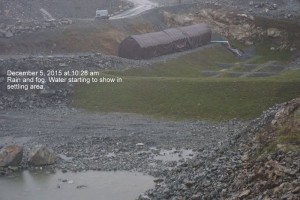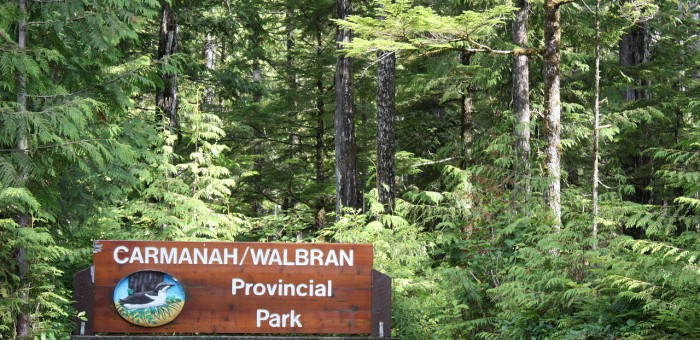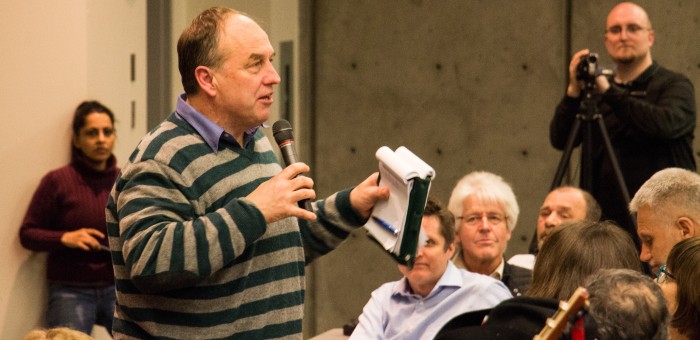Issues & Community Blog - Andrew Weaver: A Climate for Hope - Page 134
British Columbia’s Family Doctor Shortage
With over 4.5 million Canadians in need of a family physician, Canada appears to be facing the largest doctor shortage since the creation of Medicare in 1968. Our practicing physician to patient ratio landed us 17th out of 21 in a 2006 OECD report on physician services and the situation hasn’t improved since – despite being the focus of many political promises.
Figure 1: Percentage of Canadians without a family doctor by age, group and sex aged 12 and over. a) For various age groups; b) Averaged 0ver all ages. Data from Statistics Canada.
Over the last few years, the B.C. Liberals have repeatedly vowed that every British Columbian would have a family doctor by 2015. In 2010 then Health Services Minister Kevin Falcon announced that the Province was going to overhaul its primary health-care system with a $137-million investment to “strengthen service delivery, ensure patients are full participants in their care and provide every British Columbian who wants a family doctor with one by 2015.”
Figure 2: Practicing physicians per one million population for several countries. Repropduced from the OECD report: The Supply of Physician Services in OECD Countries.
In February of 2013 the BC Liberals renewed their commitment with the $132.4 million ‘A GP for Me’ pilot program they said would ensure everyone who wanted a family doctor would be able to access one within two years.
“The objective is clear, all British Columbians will have access to a family physician…” Unfortunately, 2015 has come and gone and there are an incredible number of people still in need of a family doctor.
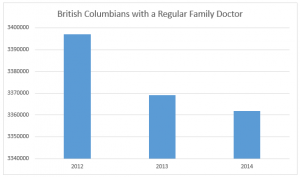 In fact, fewer British Columbians have a regular doctor now than before the government made those lofty promises. According to Statistics Canada, in 2012 3,397,007 people in BC had a family doctor. By 2013 that number had fallen by 27,947 to 3,369,060. In 2014 it was lower still at 3,361,856.
In fact, fewer British Columbians have a regular doctor now than before the government made those lofty promises. According to Statistics Canada, in 2012 3,397,007 people in BC had a family doctor. By 2013 that number had fallen by 27,947 to 3,369,060. In 2014 it was lower still at 3,361,856.
Despite the incredible amount of money that has been thrown at this problem, today in British Columbia it is estimated that over 200,000 people are still actively looking for a family doctor.
When facing a problem of this magnitude and complexity, it is important to look back at the policies and regulations that got us here. While there are no doubt countless contributing factors that influence doctor shortages, what follows is an overview of the major changes that shifted our course towards one critically deficient in family physicians.
In 1961, the average medical ratio in BC was 758 patients for each doctor. Much like today, however, the rural-urban distribution of doctors was uneven. In rural areas the ratio was much higher, at 1,229 patients per doctor, and 73.6% of the province’s physicians were concentrated in Vancouver and Victoria.
Sensing problems ahead, the federal Royal Commission on Health Services (who outlined the foundation for Canada’s universal medicare system) analyzed the medical workforce statistics and predicted an overall shortage of doctors by the 1970’s (source available in hard copy only, page 246). Along with increasing med-student intake at universities across the country, the report recommended the establishment of at least four additional medical schools to meet the needs of a growing population. Their shortage projections extended until 1991 (page 70).
When 1991 arrived, however, the perceived supply of doctors did a rapid reversal. A report presented to the Federal/Provincial/Territorial Conference of Deputy Ministers of Health by Barer and Stoddart cautioned that we were, in fact, heading towards a doctor surplus. Public policy shifted accordingly and drastic changes were made to the way physicians were trained and licensed in Canada.
Barer and Stoddart were concerned that there were too many doctors, especially in urban areas, and that this would put people at risk of being over-treated as physicians (who bill per patient) competed for limited cases (page 11, 48-50). This theory of “physician-induced demand,” it should be noted, has always been a controversial and inconclusively proven phenomenon (page 19). Nevertheless, Barer and Stoddart recommended limiting med school entry and reducing the use of foreign-trained physicians and governments followed suite.
In BC, the government introduced a combination of incentives and penalties in the hopes of shifting more doctors away from city centers and into remote areas. By 1993, travel assistance, isolation allowance, and subsidized, salaried positions were offered to doctors willing to move to more rural locations. At the same time, the government tried to manage doctors as they prepared to enter or exit the workforce. Young doctors looking to set up practices in areas deemed “oversupplied” were met with a 50 per cent reduction in their fee-for-service rate. This penalty only lasted a few years though, as it was challenged by physicians and the Professional Association of Residents of British Columbia and in 1997 ruled unconstitutional by the BC Supreme Court. The Court deemed the fee penalty imposed on urban doctors as a violation of the Canadian Charter of Rights and Freedoms guaranteed mobility and equity clause, as well as a breach of Canada Health Act’s requirement for reasonable compensation for insured services (page 24). Mandatory retirement caps set at 75 year were removed as well, following a legal challenge by the Senior Physician Society of BC (page 25).
A few years later, however, opinions had shifted yet again and the public and policy makers were back to being worried about a serious national doctor shortage. Incredibly, within a span of a decade the believed supply of doctors had done a complete reversal. A 2002 report for the Canadian Institute for Health Information, From Perceived Surplus to Perceived Shortage: What happened to Canada’s Physician Workforce in the 1990s?, cited changes to postgraduate medical training programs as the largest contributing factor. By extending the residency requirement for general practitioners there was an extra delay on new doctors entering the workforce. In addition, a higher proportion of medical students elected to specialize, further limiting the number of family doctors (page 36). At the same time more doctors were retiring, fewer students were being accepted to medical school, and the number of positions available to foreign-train doctors dropped – all while the general population continued to increase and get proportionally older.
Five years after the BC government was taken to court for reducing urban doctors billing rates they were back to offering generous financial incentives. Retention Allowances were introduced in 2002 to encourage doctors to start practices in smaller communities. The Northern and Isolation Travel Assistance Outreach Program covered travel costs and accommodation for physicians service isolated communities. In 2007 the Family Physicians for British Columbia program paid $100,000 to doctors willing to establish full service practices for at least three years in underserved areas. That year not one doctor stepped forward to accept any of the 15 Interior Health incentive packages.
Picking up on research that suggests medical students recruited from rural backgrounds are more likely to work in non-urban areas after graduating, the BC government announced plans to expand and upgrade teaching hospitals around the province. They also increased province wide first-year enrollment from 128 in 2001 to 256 in 2007 and authorized the creation of three additional medical campuses at UVic, UNBC, and UBC Okanagan.
Backtracking on foreign-trained doctor restrictions, International Medical Graduates were once again seen as part of the solution to physician shortages across Canada. Canada has never trained enough physicians to meet the country’s needs and foreign-trained doctors account for roughly a quarter of the medical workforce in Canada. Though securing a position is incredibly competitive for non-Canadian doctors, they do account for roughly 38% of Newfoundland and Labrador’s physicians and 46% of Saskatchewan’s. Unsurprisingly, the logistics of integrating and licensing foreign-trained physicians are clumsy and slow, though some medical colleges are recognized as accredited and approved by the College of Physicians and Surgeons of British Columbia which streamlines applications.
In 2007 the college was licensing 100 to 150 foreign doctors per year and in the 2008 Speech from the Throne the BC government promised that a “new framework to allow Canadian citizens trained outside of Canada to find residencies and practices in B.C. [would] be developed and implemented.”
This included a new health profession review board to “ensure that all qualified health workers can fully and appropriately utilize the training of skills and not be denied that right by unnecessary credentialing and licensure restrictions.”
Bill 25, the Health Professions (Regulatory Reform) Amendment Act, introduced in April of the same year provided the legislative structure for these changes
Despite these initiatives the practice of importing doctors is not without controversy and many jurisdictions are trying to become less dependent on them. In 2001 the High Commissioner to South Africa asked Canada to stop depleting the supply of doctors in his country where hospitals were desperately underserved. “Immigration of doctors can ease physician shortages in countries where numbers are lacking but it raises difficult questions about international equity when there are net, long-term flows of physicians from poorer countries with low average health status to richer countries with high health status,” writes Simoens and Hurst’s report on the supply of physicians in OECD counties. “As a result, many OECD countries aim for self-sufficiency in physician supply.”
One possible alternative to the geographically uneven distribution of doctors in BC is the use of “Telehealth” services which use videoconferencing technologies to connect doctors and patients. There are concerns about privacy and insurance coverage with these systems, but the presence of nurses to facilitate calls and operate examination cameras on the patient side do make them feasible in certain scenarios.
The certification of more nurse practitioners is also seen as a promising way to increase patient care while reducing relative health care costs. Nurse practitioners were first regulated in BC in 2005, not as a substitute for doctors, but a compliment. When paired with doctors they can streamline patient care by treating routine illnesses and injuries while physicians handle more complex diagnoses. Nurse Practitioners are able to diagnose, consult, order and interpret tests, prescribe, and treat health conditions. They work in both independent and collaborative practice roles across BC and practice acute care, outpatient clinics, residential care and community settings.
Now at the start of 2016, we find ourselves once again repeating history as we offer doctors a patchwork of financial incentives in an attempt to meet the province’s growing medical needs.
Currently, in addition to recruitment incentives ($15,000 or $20,000), relocation incentives ($15,000), the rural retention program, isolation allowance, and various other training bursaries, rural physicians receive a one-time payment of $100,000 for a commitment to work for three years in a designated rural communities. The incentive is available to family practitioners, specialists and residents who are paid $50,000 when they start work in the community and the remaining $50,000 after one year.
In some situations these economic bonuses have changed the problem, without improving the overall situation. The current set up gives doctors the ability to work less while earning more, and one can hardly fault them for making the most of it. As the graphs from the MSP Physician Resource Report below indicate, the total expenditure for general practice doctors has increased significantly since 2005, but the average number of patients treated per physician has dropped. The government’s policy changes over the last ten years have lead to more doctors, working less days, treating fewer patients. An important, though further complicating, caveat to this data is that it focuses on quantity of care – not quality. In many cases doctors seeing fewer patients is a positive change as it indicates they are spending more time with each individual. For people struggling with multiple or complex conditions this added assistance is essential.
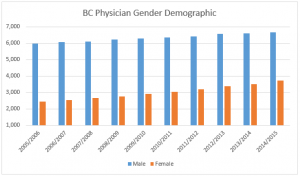 With more female doctors, who statistically allocate more time to each patient, practicing in BC than ever before and doctors in general striving to create a healthier work life balance, the policies used to influence the doctor shortages of the 1970’s are no longer relevant. Family doctors play a vital role in our well being and they deserve a policy framework that lets them treat patients in a manageable, fulfilling, and efficient manner.
With more female doctors, who statistically allocate more time to each patient, practicing in BC than ever before and doctors in general striving to create a healthier work life balance, the policies used to influence the doctor shortages of the 1970’s are no longer relevant. Family doctors play a vital role in our well being and they deserve a policy framework that lets them treat patients in a manageable, fulfilling, and efficient manner.
Given this province’s complicated history with doctor shortages, what is most concerning about the BC Liberal’s promise to provide every British Columbian with a family physician is not that they have failed – one only has to look back at the struggles Canada has had maintaining an appropriate number of GPs to know BC’s doctor shortage was never something that could be fixed in two years. What is most concerning is that British Columbians were repeatedly mislead about what could be realistically achieved.
We’re beginning to see a pattern emerge with this government. Whether it be promises of 100,000 LNG jobs, a debt free BC, or a GP for every British Columbian, the government is long on rhetoric and short on policy grounded in evidence. British Columbians deserve better. They deserve a government that is transparent and honest with its expectations and promises.
Over the next year, and in collaboration with my policy advisors, I will be outlining ways we might consider to alleviate the British Columbia’s GP crunch.
If you have ideas you would like to share with me and my team, please don’t hesitate to email us at: Andrew.Weaver.MLA@leg.bc.ca
COP21 Targets Require Ambitious Policy
Media Statement December 14, 2015
COP21 Targets Require Ambitious Policy
For immediate release
Victoria B.C. – Andrew Weaver, MLA for Oak Bay – Gordon Head and Leader of the B.C. Green Party welcomes the Paris climate agreement but cautions that it is only a first step towards reducing global greenhouse gas emissions.
The COP21 accord is non-binding and is designed to keep global temperatures to well below 2°C above preindustrial levels. “The world has already warmed by about 1°C and existing atmospheric carbon dioxide levels commit us to a further 0.6°C,” notes Weaver. “When you add in an additional warming of between 0.2 and 0.3°C from the permafrost carbon feedback, it makes it imperative that nations put forward far more aggressive greenhouse gas reduction targets than have been offered to date. The existing voluntary national targets make it virtually certain that 2°C warming will be broken this century.”
While the agreement includes all 195 nations and has legally binding provisions for the five year review, the targets are still voluntary and lack the policy measures needed to achieve the collective goal. Furthermore, until the World Trade Organization is part of the negotiations, it will be very difficult for any nation to enact policies that account for discrepancies in transjurisdictional emissions. “Countries that aggressively act to reduce emissions through carbon pricing need the ability to apply carbon tariffs on imports from jurisdictions that don’t,” adds Weaver.
“I am cautiously optimistic” said Andrew Weaver, “all countries have agreed to reduce emissions. In addition, developed nations have agreed to assist developing nations in adapting to a changing climate and to facilitate the transfer of clean technology.”
Andrew Weaver further notes that “For Canada to be recognized as a climate leader British Columbia must be part of the solution. We have an enormous opportunity in B.C. to invest in renewable energy such as solar, wind, and geothermal, as well as to further advance these sectors and globally export technology and expertise.”
British Columbia has the opportunity to harness natural resources, a nascent and growing clean tech sector, and skilled workers ready to accept the challenge. The current government, however, is actively heading the opposite direction by continuing to support high carbon industries like LNG and thermal coal. They have already stated they will not meet the mandated 2020 targets and the assurance by Premier Clark that LNG exports will somehow offset growing provincial greenhouse gas emissions is completely misguided.
“Ambitious targets require ambitious policy,” said Andrew Weaver. “To achieve a national transition to a low carbon economy our policies, political support, and subsidies need to shift away from backing the fossil fuel industry and start actively encouraging the clean technology sector.”
Media Enquiries
Mat Wright
Press Secretary – Andrew Weaver MLA
1 250 216 3382
mat.wright@leg.bc.ca
Ministry abdicates its responsibility to Shawnigan Lake residents
On December 2 I sent a letter to the Minister of Environment. In the letter I expressed my concerns regarding the ongoing activities at the site in the Shawnigan Lake watershed where contaminated soils are being delivered. My letter was initiated in response to the release of two Cowichan Valley Regional District (CVRD) reports.
As noted in the Thurber Engineering Ltd report, “The presence of the large volume of water emerging from under the rock armour at the head of the ephemeral stream indicates that runoff storm water sourced from the SIA site is bypassing the sediment pond (i.e by flowing under it) and is being discharged directly onto the land owned by the CVRD”.
Below I provide photographs of the sediment pond [panel a], as well as a large pond beside the sediment pond [panel b]. The report suggests that much of the water bypasses the sediment pond and leaves via an ephemeral stream [panel c].
I have yet to receive a response to my letter but I note that the Ministry responded directly to the CVRD’s letter sent on the same day as mine. The ministry has also detailed their timeline of compliance and monitoring.
In the Ministry’s response to CVRD they state:
The Letter
The Honourable Mary Polak
Minister of Environment
Room 112
Parliament Buildings
Victoria B.C.
December 2nd 2015
Dear Minister Polak,
On December 1st 2015 the Cowichan Valley Regional District released an engineering report, commissioned by the district, evaluating unauthorized water discharge from the contaminated soil treatment site managed by Cobble Hill Holdings Ltd. near Shawnigan Lake. The Thurber Engineering report titled ‘Storm Water Management Observations, South Island Aggregate’ is clear and blunt in its assessment:
“The presence of the large volume of water emerging from under the rock armour at the head of the ephemeral stream indicates that runoff storm water sourced from the SIA site is bypassing the sediment pond (i.e by flowing under it) and is being discharged directly onto the land owned by the CVRD”
The report also concluded the sediment pond meant to hold water runoff from the site is ‘relatively porous’ and therefore completely inadequate as a containment system.
In addition, on November 18th 2015, Jennifer McGuire, Executive Director of the Ministry of Environment Regional Operations Branch, issued a formal warning letter to Cobble Hill Holdings regarding permit PR-105809 raising concerns regarding the ability of the operator to ensure effective operation of the site and to manage unauthorized discharges in accordance with the license.
These are only the most recent developments following months of gathered evidence and serious concerns on water quality raised by the residents and property owners around Shawnigan Lake, the CVRD, Island Health, Cowichan Tribes, myself and others.
In light of this I am asking you use your authority and prerogative as Minister of Environment to:
1: Immediately suspend permit PR-105809 and order the operator to cease operations.
2: Commission an independent engineering firm to evaluate water source, flow and containment, bedrock analysis and operating and emergency procedures to determine if the site can be remediated to comply with the permit.
I am available to discuss this at your convenience and look forward to your immediate attention.
Sincerely
Andrew Weaver
MLA – Oak Bay – Gordon Head
Protecting Old Growth Forests on Vancouver Island
This week I sent a letter to the Minister of Forests, Lands and Natural Resource Operations regarding the ongoing dispute in the Walbran Valley. I was inspired to do so after receiving thousands of emails from British Columbians expressing their concerns about the Teal-Jones Group’s intention to log cut block areas in the Walbran Valley and other old growth forests on Vancouver Island.
Old growth forests provide many important environmental and social functions, serving as homes to numerous species at risk and as popular recreation areas for locals and tourists alike. It is time that they receive a level of protection that reflects their importance to both our ecosystems and our economy.
To ensure this, it is necessary that we take an ecosystem focused and science based assessment in decisions concerning forestry management, and I am concerned that this is not what our government is doing. Instead, by playing the environmental and social concerns off against economic ones, they are merely allowing an unsustainable status quo to continue.
Protecting our remaining old-growth forests while building our forest industry do not have to be competing objectives. It is time that we take a closer look at the status quo in forestry management in our Province, and ensure that we are looking at all the factors – social, environmental and economic – when we are making decisions.
Please see below to read my letter to the Minister in full.
Letter to the Minister of Forests, Lands and Natural Resource Operations
Dear Minister Thomson,
I am writing to you with regards to the ongoing dispute in the Walbran Valley, concerning the Teal-Jones Group’s intention to log a cut block in the area.
My office has received over 3000 emails from British Columbians, expressing their concerns about the continued logging of old-growth forests on Vancouver Island.
Old growth forests serve numerous environmental and social functions that need to be better protected. I am concerned that the government’s current approach to this issue implicitly plays the environmental and social concerns off against economic ones.
Similar to how this government has gone about updating our water management, it is essential that we take an ecosystem focused and science based assessment in decisions concerning forestry management. Anything less is merely allowing an unsustainable status quo to continue.
Protecting our few remaining old-growth forests while building our forest industry do not have to be competing objectives. It is time that we take a closer look at the status quo in forestry management in our Province, and ensure that we are looking at all the factors – social, environmental and economic when we are making decisions.
Within this context, I am hoping to get an explanation as to how the government is making its decisions regarding logging in old-growth forests on Vancouver Island.
I look forward to your response.
Sincerely,
Andrew Weaver
MLA, Oak Bay-Gordon Head
Lack of Poverty Reduction Plan in British Columbia Unacceptable
Media Statement: December 10, 2015
Andrew Weaver: Lack of Poverty Reduction Plan in British Columbia Unacceptable
For Immediate Release
Today, Andrew Weaver, MLA for Oak Bay Gordon Head and Leader of the BC Green Party, reiterated his call for the Provincial Government to develop a comprehensive strategy to end poverty in our province. British Columbia is now the only Province without a poverty reduction plan, yet is projected to have the fastest growing economy in the country.
“It is unacceptable that in a province with an economy as strong as ours that we are the only ones neglecting our responsibility to our citizens who are struggling to afford the cost of living,” said Andrew Weaver.
An October 2015 report by Citizens for Public Justice showed British Columbia had a 16.3% overall poverty rate and was the only province left that had not advanced a poverty reduction strategy. CIBC World Markets released a report in November predicting British Columbia would lead the country in terms of economic growth in 2016.
In response to the tent community on the lawn beside the Victoria Law Courts, the government has pledged more money for a new shelter in the region, and that campers would be asked to leave if they didn’t accept the province’s offer of housing. The Premier also suggested that the best way to fight poverty was to let the economy grow.
“This is what is wrong with our poverty reduction policy in British Columbia,” said Andrew Weaver. “We have a government that advances short term solutions like shelters, while suggesting for years that we need to wait for our economy to grow before we can take real action. Now we have the fastest growing economy in the country and we still haven’t advanced a plan.”
Other jurisdictions are finding ways to address poverty issues while saving the government money. Housing-first poverty strategies have been one of the foundational aspects of poverty reduction plans in Utah, Denver, Medicine Hat and a growing number of other jurisdictions. This approach recognizes housing insecurity as a key systemic issue contributing to poverty and shifts from emergency management of homelessness, to providing homes for those who need them. By addressing this issue head-on, rather than through a patchwork of services, government costs are ultimately reduced.
“A good place for a poverty reduction plan to start would be addressing the difficulties British Columbians are having finding affordable and supportive housing,” said Andrew Weaver. “This isn’t an either or – we need to continue to develop a strong economy, while ensuring that British Columbians aren’t being left out in the cold.”
-30-
Media Enquiries:
Mat Wright
Press Secretary – Andrew Weaver MLA
Cell: 250 216 3382
Mat.wright@leg.bc.ca
Twitter: @MatVic
Parliament Buildings
Room 027C
Victoria BC V8V 1X4


